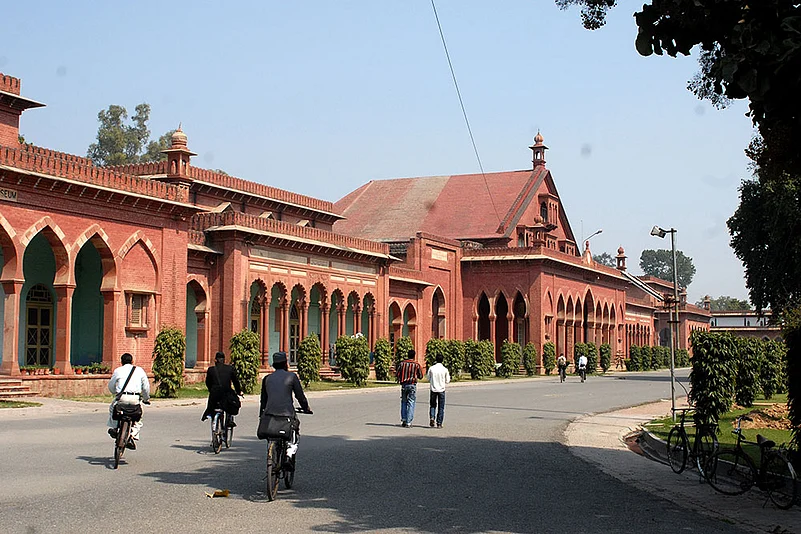It may evoke incredulity, but browsing through historical documents, it seems even the Banaras Hindu University (BHU) was envisaged as a minority institution. The Central Hindu College in Benares, which later became BHU, and the Mohammedan Anglo Oriental College in Aligarh, which later became the Aligarh Muslim University, were established in the latter half of the 19th century by social visionaries Annie Besant and Sir Syed Ahmad Khan for the advancement of the Hindu and Muslim communities. What the two communities wanted were their own universities where, unlike at state institutions, secular education could be accompanied by religious instruction. This is the fundamental distinction between a state-run and a minority institution.
The term ‘minorities’ has been used only in four places in the Indian constitution, which interestingly gives no definition of the term. Numerical inferiority and powerlessness are recognised indicators of minority status. Since religious and linguistic minorities have the same rights, and since states were created on a linguistic basis, minority status is determined at the state level. The Supreme Court has consistently maintained that any group constituting less than 50 per cent in a state is a minority. During British rule, a white minority was ruling India, so Hindus were a minority by virtue of their powerlessness. And Muslims were not only numerically inferior, they were also powerless in every sense of the term. Thus, Hindus and Muslims were indeed religious minorities till 1947.
The colonial British government was absolutely clear that BHU and AMU were not state institutions like the Bombay, Madras and Calcutta universities. That’s why it had the Bills for their creation introduced by Hindu and Muslim members of the Imperial Legislative Council. Recognising the minority character of the proposed universities, it allowed the two communities to draft the Act, statutes, regulations etc of their universities.
So it is disgusting to see that, while the alien British government, even in the absence of Article 30, extended the necessary support to get the BHU and AMU Acts passed in 1915 and 1920, the BJP has taken the position that Parliament has no power to pass Acts incorporating minority universities. The BJP’s stand is basically an assault on the powers of Parliament and the assemblies to incorporate minority universities. A number of minority universities have been incorporated under various state Acts. Besides, there are some minority “deemed to be universities” under Sec 3 of the UGC Act of 1956 which have been given university status by the HRD ministry. The stand taken by the attorney-general encroaches upon the minority character of all these universities.
In response to the demand for the Hindu university, the British government had written to the Hindu leaders that there would be some governmental supervision. Also, that the movement for the Hindu university must be purely educational, not political. They were told the term ‘Hindu’ was not acceptable in the nomenclature, the university would not have affiliating powers, and that the Viceroy couldn’t be the chancellor of the univerity. The Hindu leaders resisted and were told they should follow the Muslim leaders, who had earlier opposed similar conditions, delaying the passage of the AMU Bill by more than a decade. (After initial reluctance on the part of Hindu leaders, the BHU Bill was passed in 1915; the AMU Bill could only be passed in 1920, with much greater autonomy for AMU.)
Article 30 gives both religious and linguistic minorities the right to establish “educational institutions of their choice”. In a catena of cases, the Supreme Court has held that the crucial words are “of their choice” and it’s within the powers of the minorities to expand their choice as much as they want.
In fact, the two communities had made the choice to have these denominational universities. To enhance the stature of their universities, they (particularly the Muslims) initially desired a royal charter or an Act of Imperial Parliament, but since the Secretary of State did not agree, they eventually agreed to an Act by the Governor-General in Council. As private minority universities, they were aware they would not be able to raise the requisite funds if their universities did not have a structure similar to state universities. Moreover, since the “right to administer” does not include the “right to maladminister”, the two communities agreed to some supervision. The colonial regime accepted their request and got the two minority universities incorporated.
In 1967, the Supreme Court, without going into the details and context of these negotiations, erroneously termed this a surrender of the minority character of AMU. Since both communities were compelled to agree to the terms offered by the Secretary of State, they cannot be said to have agreed of their own free will. Moreover, the Secretary of State, in London, was extremely prejudiced against Indians, particularly about these community-driven institutions, and did his best to curtail their autonomy.
AMU’s minority character was thus taken away by the apex court without even hearing it. It adopted the strange logic of looking at the AMU Act, 1920, to determine its minority character, and after examining it, concluded it is not clear that the university was established by the Muslims of India. Parliament amended the AMU Act, 1920, in 1981 and clarified that AMU was indeed established by Muslims. The constitutionality of this amendment is under challenge in the apex court.
The Supreme Court also attached undue significance to the “recognition of degree” provision of the AMU Act to hold that in lieu of this being granted, the Muslim community surrendered AMU’s minority character. There’s a similar provision in the BHU Act. As to the recognition of degrees of AMU, there is no mention of it in the negotiations with the British government. Recognition of degrees was part of the ‘choice’ made by the two communities. The respective Acts made the degrees of the two minority universities at par with the degrees of other incorporated universities. After independence, we cannot take the position that degree recognition destroyed the original minority character of AMU and BHU. In any case, the Supreme Court failed to appreciate that the Constitution does not permit waiver of fundamental rights and therefore the theory of surrender of minority character in lieu of degree recognition is certainly flawed. The decision has rightly been criticised as “productive of great public mischief”. In 2016, the Supreme Court has the opportunity to overrule its regressive judgment.
Like AMU, BHU too was certainly a minority university when incorporated. It was established by Hindus, for Hindus. Its apex body, called ‘court’, was to consist only of Hindus. At AMU, the ‘court’ was to consist only of Muslims too. The 1951 amendment deleting the provision of exclusion of non-Muslims did not change the fact of Muslim domination of the court. Just because sovereign legislative power was invoked by the two communities to incorporate their universities in no way impinges on original minority character.
After independence, Hindus lost their minority status as they not only retained their numerical superiority in Uttar Pradesh but also converted their non-dominant status into a dominant one in the power structure. They replaced the British as a ruling class. Since Hindus lost their minority status in UP, BHU too lost its minority tag. Had Varanasi been part of Punjab, Kashmir or some northeastern state, BHU would have continued to be a Hindu minority university. Similarly, God forbid, if Hindus ever become less than 50 per cent of UP’s population, BHU would get back its original minority character.
The Nub
Complex negotiations with the British government had preceded the creation of the BHU and AMU. Both universities would have found it extremely difficult to raise all the money required independently. Adhering to the structure of a state university would give them the catchet that would attract donations, so they agreed to some government supervision. But the SC in 1967 interpreted this as surrender of minority character.
(Faizan Mustafa is vice-chancellor, Nalsar University of Law, Hyderabad.)

























